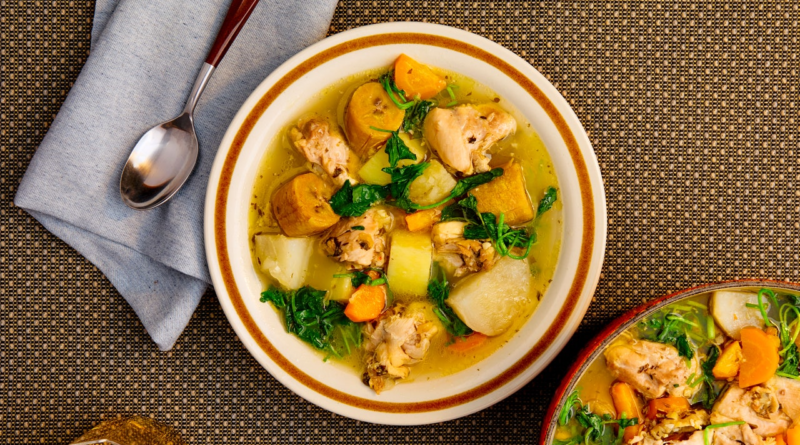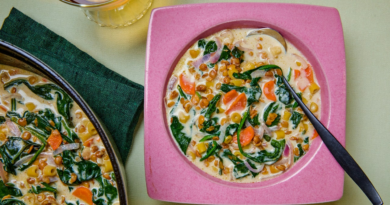Haitian Bouillon
Haitian bouyon is somewhere between a soup and a stew. Often made with beef, in our house it’s only ever made with chicken. The meat is simmered with herbs and aromatics, similar to the method found in Poul ak Nwa (a traditional Haitian dish with stewed chicken and cashews), combined with veggies and viv (called provisions in the English-speaking Caribbean, referring to starchy vegetables commonly found in the region’s cooking—tubers and plantains were some of the few things the enslaved were allowed to grow on their own plots of land). This is the recipe that was made for me most days after I’d given birth to our daughter. While I usually prefer to streamline a process where I can, here I concede to tradition: It works best to cook the provisions separately, allowing the chicken to create a rich broth, which is bolstered later by the starch from the provisions’ cooking liquid.
The yellow yam, Dioscorea cayenensis—not at all the same thing that’s used at Thanksgiving—will start to discolor as soon as it is exposed to air, so put the cut pieces in a bowl of cold water until it’s time to boil them. The patat will also discolor immediately and break up easily, so it’s best to cook it separately and add at the end. Other provisions that work are cassava, taro, or malanga. If you can’t access any of these tubers, which can be found at Caribbean, African, and sometimes Asian groceries, regular potatoes (like russet and Yukon Gold) and Japanese sweet potatoes make decent substitutes. Any kind of green works well in addition to, or in lieu of, the watercress; try spinach, shredded kale, collards, or Swiss chard. If you’re using a hardier green, let it simmer a few minutes before serving. This recipe uses chef and cookbook author Gregory Gourdet’s epis recipe that he created for his beans and rice dish, Diri Kole ak Pwa, featured in the February 2022 issue of Bon Appétit; you can also use my version, which I wrote about for the site.
Some helpful tips: To peel plantains, cut off the ends, then slice through the skin lengthwise, being careful not to cut the flesh. Work your thumb (or a small spoon) under the skin and pull up along the slit. The skin will come off in large strips.
To cut skin-on, bone-in chicken thighs, place them skin down on your cutting board. Using a heavy chef’s knife, make a cut in the flesh where you want to chop. Focusing on this area (like you’re in a yoga class), hold the knife firmly, pull back and come down hard on the spot you marked. You may have to do this a few times, but the knife will cut through the bone, and you’ll be amazed how you’re able to hit the same spot again and again.
Read More: The Bouyon That Transported Me to Haiti After Childbirth



